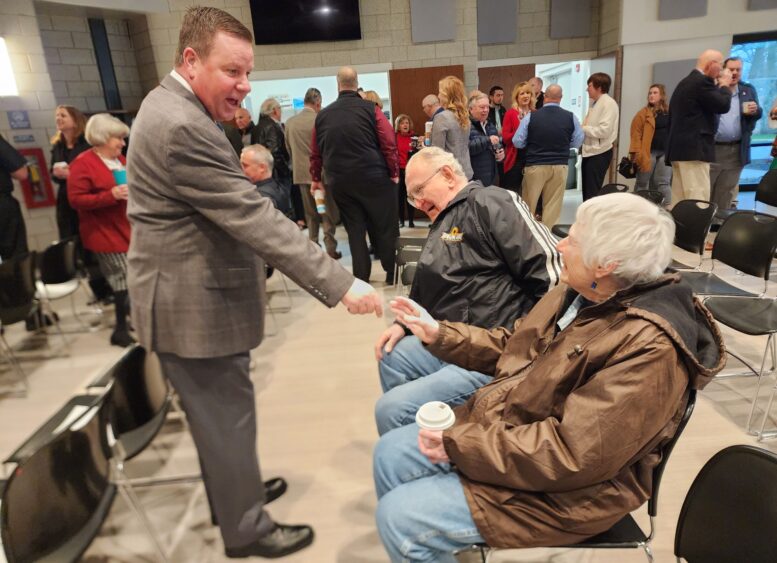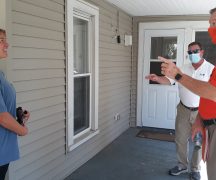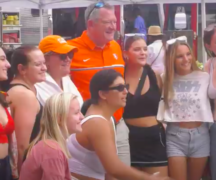By JAN McLAUGHLIN
BG Independent News
State of the City speeches are normally a time for mayors to talk about successes and soak up the spotlight. But on Thursday morning, Bowling Green Mayor Mike Aspacher shared the podium to talk about the city being its best when it partners with its educational institutions.
So Aspacher was joined by Bowling Green Superintendent Ted Haselman and Bowling Green State University President Rodney Rogers – all three emphasizing that the community is strongest when they work together for shared successes.
The mayor ticked off successes – sustained increase in enrollment at BGSU, the new high school being built for Bowling Green City School District, investments by businesses, housing starts, and city investments in infrastructure and safety.
“I have long believed that local government has the potential to impact citizens’ lives more than any other level of government, state or federal,” Aspacher said.
The city’s job is to provide the foundation for quality of life, he added.
“Because living your life is easier when you feel safe. It’s easier when you know that the water you drink is clean and will be properly treated when you are done with it. It’s easier when you know that your children will arrive safely at school each day and home again at night due in part to safe and well-maintained streets and sidewalks. And, life is easier when you know that when a storm hits, city crews will be out to restore power and clear roadways.”
“Our charge is to develop a responsible plan to move us forward while maintaining those things that help define Bowling Green and make us unique,” the mayor said.
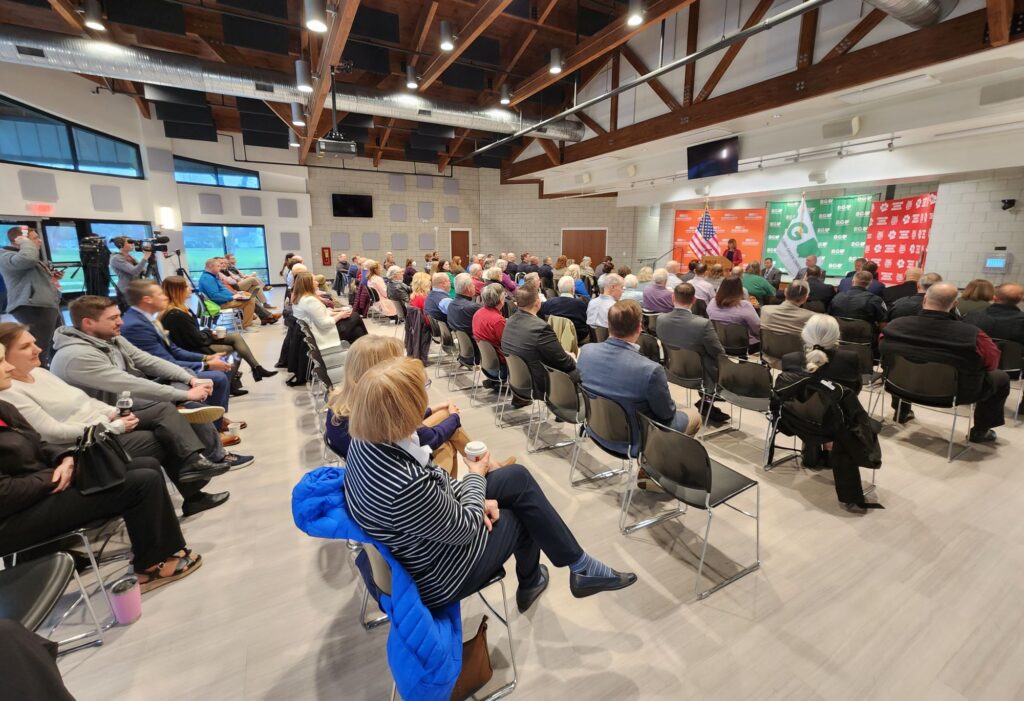
The city is at a crossroads, Aspacher said, with the school levy on the May 6 ballot making or breaking the current upward trajectory of Bowling Green.
“The excitement at BGSU is resonating throughout the town. The anticipation of the new high school has our school children excited about an improved environment for learning. Housing starts in the community are increasing. Businesses and industries already located in BG are increasing their investments in this community. We are a town investing in itself to ensure safety, reliable infrastructure, and a place where people can attain a high quality of life.”
“Let’s be persistent in our efforts to work together to advance this vibrant and authentic town. Let’s invest in ourselves and, thereby, invest in our future,” the mayor said.
A decade of controversial change
Bowling Green has faced tough issues before. Aspacher reflected on the city’s adoption of its Future Land Use Plan in 2014, when he was a member of City Council. The plan was controversial, offering straightforward, sometimes difficult to hear, feedback on the community. A study showed that without corrective action, the community trajectory would turn downward instead of upward.
“It was a time of reflection for the city, and it was a time of change,” he said.
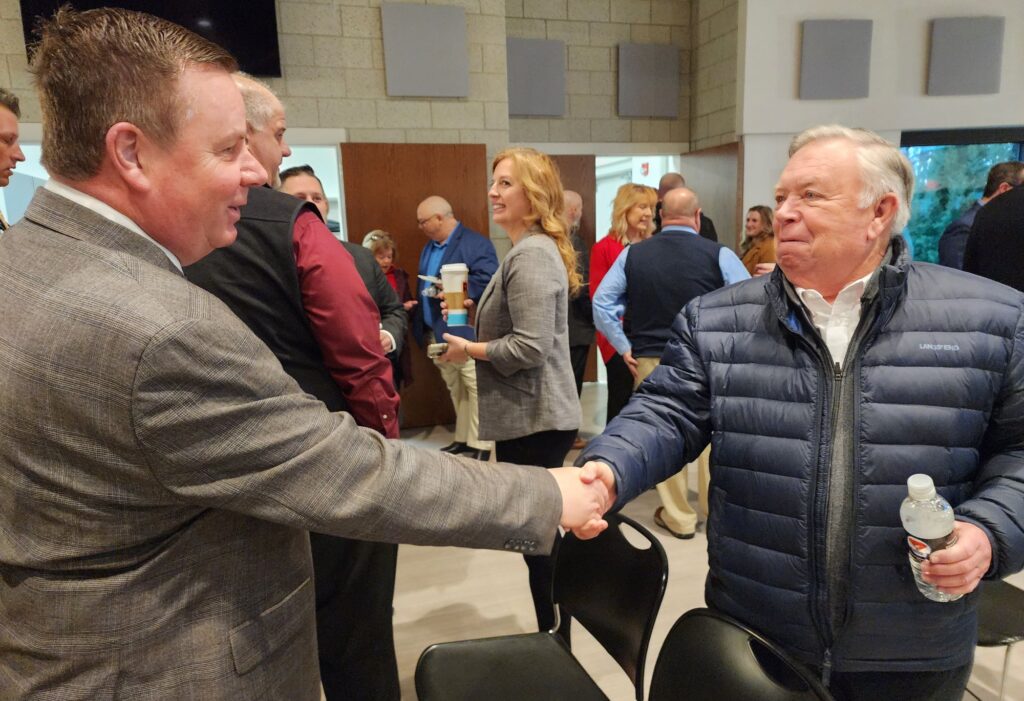
The report observed the following:
“These changes are, in fact, imperatives, across the entire U.S. They require communities to adapt. They require colleges and universities to better position themselves. They require cities and towns to become less suburban, less sprawling, less auto-oriented, and, in the process, more walkable, more identifiably unique and thus authentic, more visually appealing and marketable, more oriented towards health and fitness, more environmentally sustainable, and along the way, more fiscally sound.”
The report, then gave this warning for communities that don’t adapt:
“Households that can choose to raise families elsewhere will do so, taking with them their time, energy, and money. They will coach little league somewhere else. They will open restaurants somewhere else. They will volunteer on school boards in another community. Cities and towns that fail to make these important adaptations will find their fiscal situations becoming more precarious, not less; their infrastructure less appealing, not more. Colleges, and college towns, will find their traditional student populations smaller not larger, and the students will be weaker financially instead of stronger.”
“Well … look how far we’ve come, Bowling Green,” Aspacher said.
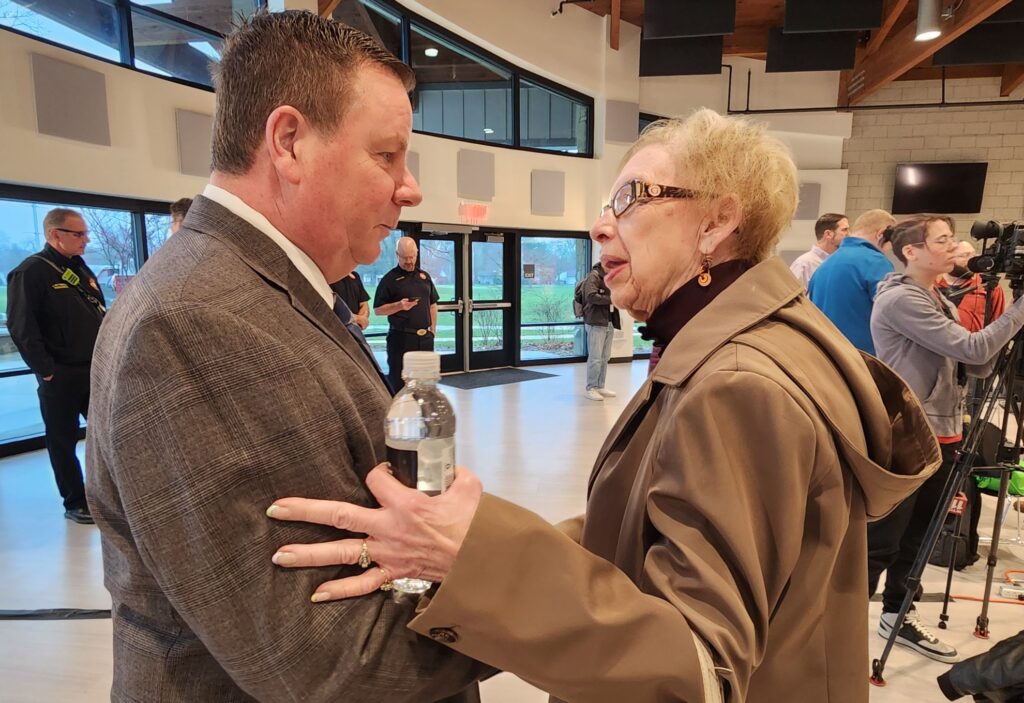
“What a gift to stand here, over 10 years later, and recognize that many of the steps and aspirations described in that document have been accomplished,” he said. “We are authentic and we are vibrant. It took work to get here. It will take work to stay here. It will take work to move forward. I know that we are capable of this work because I’ve seen it happen here, and we have all seen it yield success.”
BGSU meeting challenges
BGSU also embraced new directions to meet challenges, the mayor said.
“For many years, planners at BGSU had identified the changing landscape of higher education and openly discussed the challenges ahead. And what I find so impressive is the way that BGSU so skillfully utilized that information, made plans, and executed those plans,” Aspacher said. “While declining enrollment and other challenges are impacting many institutions, BGSU has a positive story to tell – with increasing enrollment and more academically prepared students attending the university.”
“BGSU is working directly with students on how to design their lives. This is resulting in increasing student engagement and more successful post-degree outcomes,” he said.
“A successful BGSU is good for our community. Not only for the many opportunities offered on campus for the public but also because BGSU students bring vibrancy, workforce, and commerce to the town.”
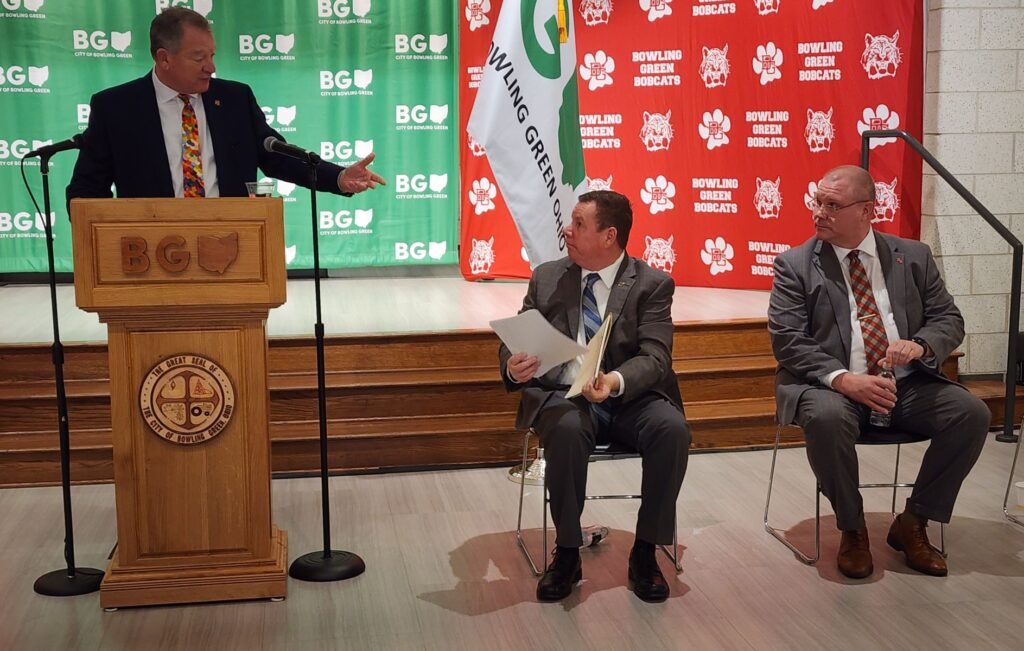
BGSU President Rodney Rogers reflected on Bowling Green being entrusted with the founding of a teacher training college here in 1910. Among the attributes of the city were the high “morals” of the community – in other words, Bowling Green back then was a “dry” city.
No longer dry, the welcoming attitude and community support for BGSU are still present today, Rogers said.
As he travels around the state talking about BGSU to potential students and their families, Rogers frequently hears comments about Bowling Green being a “great community.”
That leads to many “temporary residents” becoming full-time residents after they graduate, or returning here after trying life elsewhere. “This community so welcomes and embraces these students,” he said.
Noting the value of education, Rogers voiced his personal support for the upcoming Bowling Green City Schools operating levy on the May ballot.
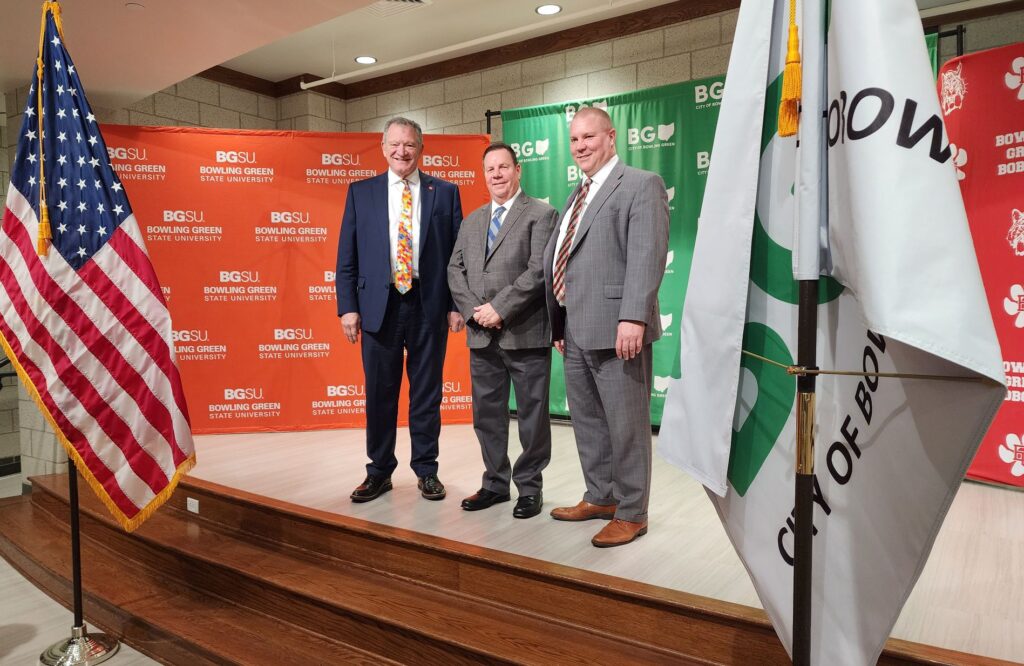
“Any great city needs great schools,” he said, citing a study showing that the strength of communities rests on access to high quality public education at the K-12 level, and the opportunity to pursue higher education.
“We’ve got to open the doors” to learning opportunities, he said. “I think it’s important we support our schools.”
“This community belongs to all of us, working together,” Rogers said.
BG City Schools at crossroads
There was a collective sigh of relief in the community after the BG City Schools passed a bond issue in 2023 for a new high school. But now the district faces a crossroads seeking voter support for an operating levy.
“Our schools continue to prove that they are worthy of this investment. They consistently demonstrate the quality of education that is being provided to students,” the mayor said.
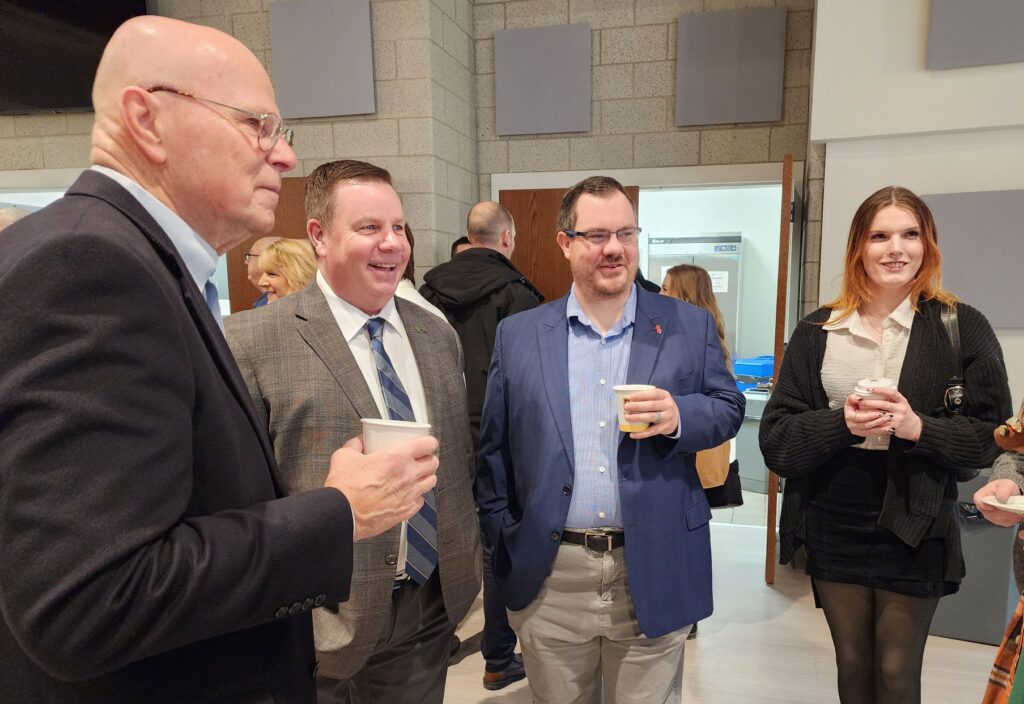
Aspacher cited several successes and recognitions earned by students in the past year.
“We must not take these outcomes for granted. Investment in community schools has been proven again and again to be beneficial to the future of our community. Modern school facilities and a school district that enjoys broad and consistent financial support help enhance the city’s economic development efforts which are focused on attracting new businesses and retaining existing businesses,” the mayor said. “Strong Bowling Green City Schools are vital to our community now and into the future.”
Aspacher professed his love for BG City Schools – the alma mater for himself, his parents, his siblings, and his children.
“We are confronted with an opportunity to influence what our school system, and to some degree, what our entire community will look like in the future. It’s time for us to step up and grasp control of the future of our schools and our community’s trajectory.”
“The upcoming school levy is not just about funding education – it is about preserving the very opportunities that make Bowling Green a place where families want to live, work, and grow. Without adequate support, our schools will lose extracurricular activities – athletics, music, arts, and the leadership programs that shape the next generation of community leaders, business owners, and innovators.”
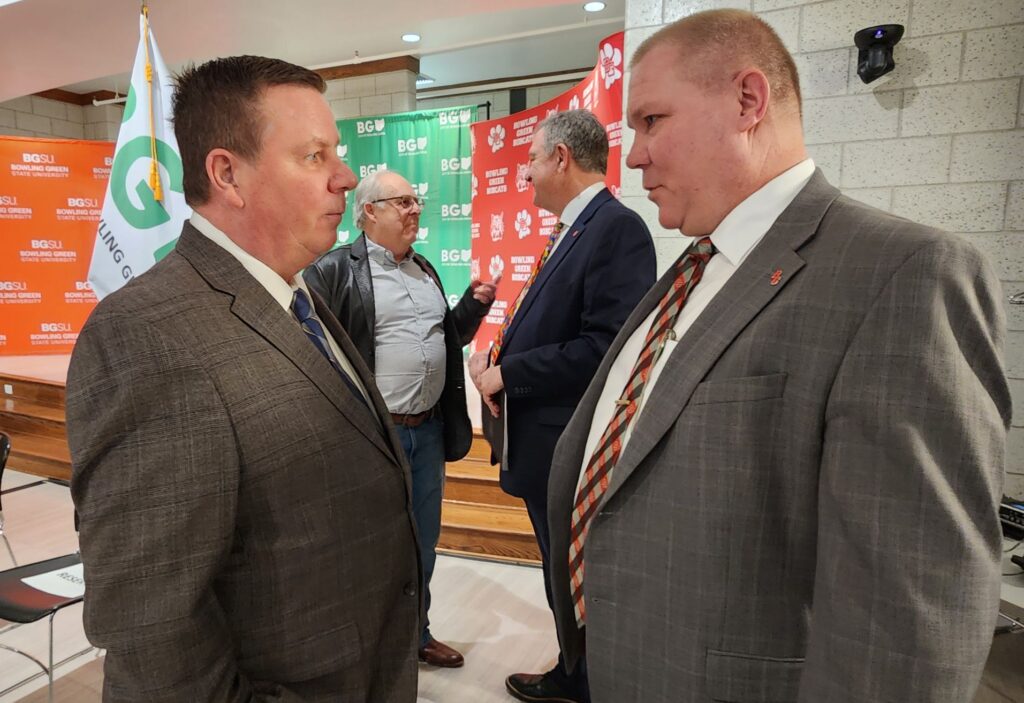
Haselman spoke of the school district’s role in the community.
“We take pride in being part of the fabric of this city – educating students, preparing them to lead with purpose, contribute meaningfully, and be proud citizens of Bowling Green and beyond,” he said.
Haselman cited success within the schools this past year, with the district receiving multiple statewide honors for academic progress, including achieving an overall rating of 4.5 out of 5 stars on the Ohio School State Report Card—an improvement from the previous year’s 4-star rating.
And ground will be broken next month for the new high school.
“But it isn’t just a building. It’s a promise. A promise to our students that they’ll learn in a space built to inspire and support their success. A promise to our community that we are investing in a shared future,” Haselman said. “The new high school will serve as a center for learning and as a hub for civic engagement, the arts, athletics, and community connection. Strong schools like ours enhance the city’s appeal – helping to attract families and businesses who want to be part of something special.”
The district has also worked to strengthen communication with the community, through electronic newsletters and social media, “Quality Profile” publications that go beyond test scores, plus printed newsletters that were delivered to 17,000 mailboxes of district residents.
“Through these various communication efforts, we are not only keeping our stakeholders informed but also fostering a culture of transparency, engagement, connection, and trust. Our goal is to ensure that every family, community member, and partner feels connected to and informed about Bowling Green City Schools,” Haselman said.
“Without this levy, I am fearful of how our schools will look,” the superintendent said. “Our district would not look the same and, consequently, our community would not look the same either. While the levy is a school district matter, it’s also a community issue – because the quality of our schools affects property values, supports our local workforce, and helps attract families and businesses to Bowling Green. Strong schools are the foundation of a strong community.”
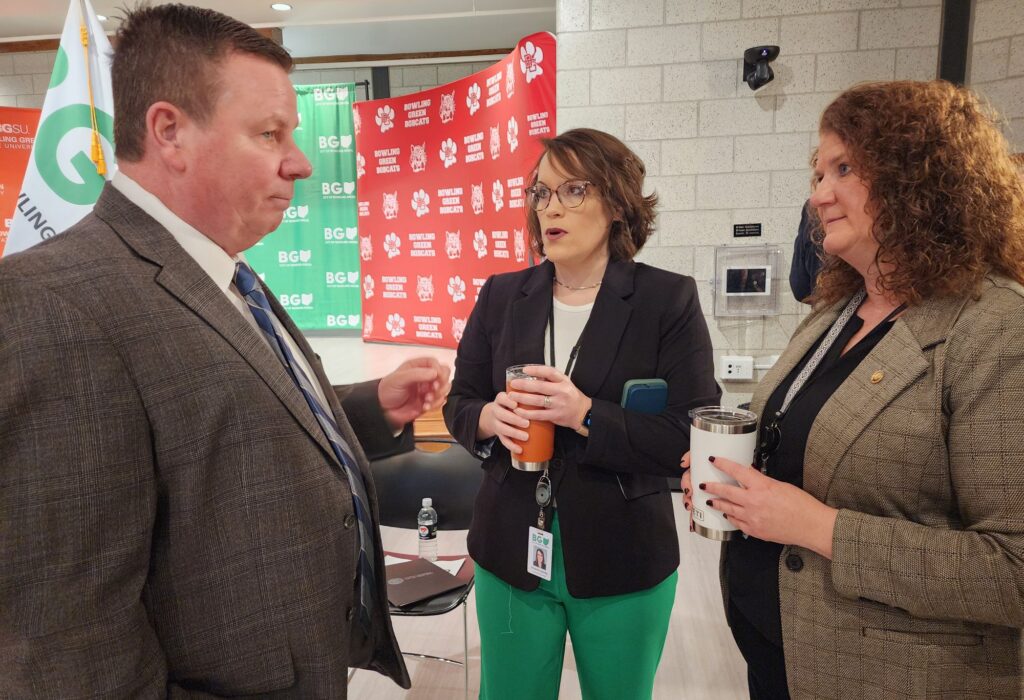
Progress on city projects
Also at the address, the mayor updated the community on ongoing projects.The city is continuing to study the needs of its safety services – planning two new fire stations, for a total of three in the city, and renovating the 100-plus-year-old police station.
Multi-modal transportation plans are underway, including improvements to South Main Street, and three multi-use pathways being built along South Main, between the high school and the community center, and linking Crim Elementary with Carter Park.
And the city is continuing investments in utility infrastructure in its water, wastewater and electric divisions.
“I am proud of our local government and the role we are playing in connecting the community to not only the resources they depend on, but also to the services they need to enhance quality of life,” Aspacher said.

